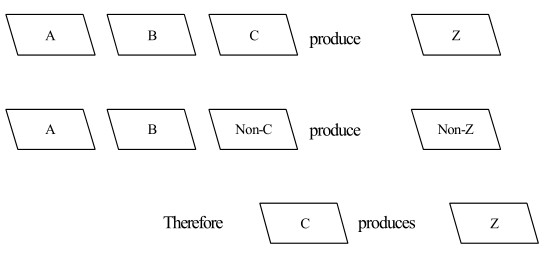This method helps in eliminating factors that are not relevant. Thus, in the above case factors A, B, D and E are to be eliminated, as they are not likely to cause Z. This method has some limitations. One limitation is that it assumes that variables that have not been considered are not relevant. One may not like to accept this assumption as there are many variables not considered but which may influence Z. Another point is that C operates only when certain other conditions exist. Finally, it may not be true that Z has occurred because of C. There may be a different cause of the occurrence of Z in each of the two situations. As against these limitations, it has some merits. First, it helps to rule out irrelevant factors, as a result of which the research problem becomes simpler. Second, it shows that certain factors do occur together. Third, it also shows that a particular factor, in this case C, always occurs before Z. It, thus, helps in eliminating extraneous factors, leaving factor C which may be the cause.
Mill’s second principle is the negative canon of agreement which states that when condition non-C is found to be associated with observation non-Z, we may hold that a causal relationship exists between C and Z.
As the logical structure of both the methods is the same, the negative canon of agreement suffers from the same limitations as the first method. Here, too, perhaps other important factors might have been left out.
It may as well as that non-C leads to non-Z only when some other factors are present.
The method of agreement and the negative canon of agreement form the basis for a third method, known as the method of difference. This method states that when there are two or more cases, and in one of them observation Z can be made, while in the other it cannot; and if factor C occurs when observation Z is made and does not occur when observation Z is not made, then one can say that C and Z have a causal relationship. This relationship is shown in Fig.5.2. In simple language one can say that the first observation shows that C could cause Z and the second shows that other possible factors could not cause Z. Fig.

Method of Difference
Mill recognised that such categorical relationships as given by the foregoing method seldom exist and he suggested another method, known as the method of concomitant variation. This method holds that “if a change in the amount of one variable is accompanied by a comparable change in the amount of another variable in two or more cases, and the latter change does not occur in the absence of the first change, one change is the cause (or effect) of the other.”
This method indicates the process of correlation which may be either positive or negative. Again, each of these can be linear or produce produce Therefore produces A B C Z A B Non-C Non-Z C Z non-linear. The causal relationship holds that changes in C lead to predicable changes in Z.
Although Mill’s canons do not offer any conclusive method to ascertain causal relationship, it may be observed that no method is perfect in this regard. As such we have to use the existing methods, though imperfect, keeping in mind their major limitations and trying to minimise their impact so that we may not reach fallacious conclusions.

